Infiniti QX80:2023 REVIEW
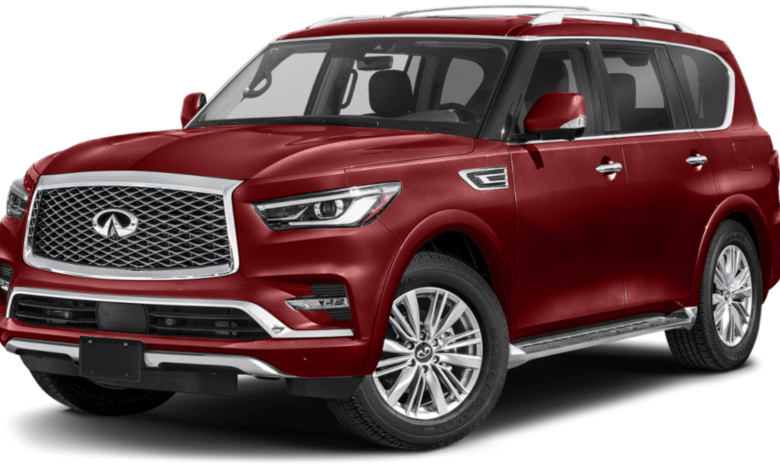
It’s not necessarily bad that the second-generation Infiniti QX80, originally known as the QX56, has been around since 2011. Luxury automakers are heavily embracing more modern technology and producing glitzy, screen-focused interiors that aren’t necessarily user-friendly. For a customer who doesn’t want or isn’t interested in the newest, best infotainment technology, the QX80 still has a pleasantly retro vibe, and it may be a great deal for a full-size, body-on-frame SUV.
The 12.3-inch high-definition touchscreen, a typical wireless smartphone charging, wireless Apple CarPlay, and USB-connected Android Auto were all included in the QX80’s most recent substantial update in 2022. For 2023, not much has changed, but the tried-and-true technology of the QX80 has received some tweaks to retain the driver’s attention on the road. The QX80 now has an integrated Amazon Alexa voice assistant and uses the steering wheel to offer haptic feedback for its lane departure warning. This year, there are three streamlined trims: the entry-level Luxe, the middle-tier Premium Select, and the top-tier Sensory.
Compared to other full-size, body-on-frame luxury SUVs, the QX80 is outdated. The Lexus LX‘s main rival had a significant makeover the previous year. The Grand Wagoneer rebirth that was “too fancy for Jeep badges” began in 2021. Then there are the Cadillac Escalade and the Lincoln Navigator, which debuted new models in 2018 and 2021, respectively. Most of them have increased their focus on lavish, cutting-edge technology, including features like unique hands-free driver assistance systems, platform design advancements that enhance their on-road manners, and interiors that depend increasingly on bigger, flashier touchscreen-based controls.

With a starting price of $74,395, which is thousands less than that of other premium SUVs, the QX80 is a fantastic value. It may not have a smoother ride or be as maneuverable around bends as some of its rivals with newer platforms, but it is still quite comfortable. The 5.6-liter V8 engine produces 400 horsepower and 413 pound-feet torque through a seamless seven-speed automatic gearbox. Although the clever, simple-to-engage four-wheel drive is an option on all levels, rear-wheel drive is the norm.
The inside is cozy and roomy, and you may choose to equip the second row with two plush captain’s seats combined with a center console or a bench to fit one extra passenger. An optional twin 8-inch screen back entertainment system is a lovely touch for longer journeys. Even the third row is more spacious than you would anticipate from a luxury SUV that isn’t a full-length Suburban. Unfortunately, the third row up limits baggage room in the back, making this SUV better suited for smaller families traveling with less luggage or more prominent families willing to utilize a roof box.
The Infiniti QX80 offers excellent value for safety features, including numerous technologies that other luxury manufacturers charge extra for, such as adaptive cruise control and lane-keeping assistance, which are included as standard on the QX80. Because it is a large SUV with an outdated chassis, it only obtained three out of five stars from the NHTSA for rollover risk in 2023. The Infiniti QX80 is a full-size luxury SUV worth considering if you want to get the most for your money.
Performance: Infiniti QX80
The Infiniti QX80 excels off the beaten path, where you want an SUV to excel. Exploring off the beaten route is simple and pleasurable thanks to 9.2 inches of ground clearance, a slow steering rack, and an accessible, simple-to-engage four-wheel drive system. Tactile dials in the center console manage drive modes and the four-wheel drive system. The seven-speed transmission’s shifts are seamless. It has trailer sway control to keep weights under control and can tow up to 8,500 pounds.
Taking the QX80 to one of my favorite gravel bars to take pictures was enjoyable. A massive naturally aspirated V8’s 400 horsepower and 413 lb-ft of torque never gave me the impression that I lacked the power necessary to maneuver over rough terrain. The steering wheel’s input is noticeably lacking since, at its core, this is a luxury car, and its designers prioritized maneuverability above the kind of feedback you’d expect from, say, a track-oriented sports car.
Nobody will mistake the QX80 for a sports vehicle with its plodding on-road demeanor. On the pavement, the QX80 feels predictable yet airy; you can feel its weight while turning. The QX80’s handling on the pavement isn’t nearly as crisp as other high-end SUVs constructed on the more recent body-on-frame platforms provided by Toyota, Ford, or GM, giving the impression that it is a generation behind its rivals.
Even Nissan’s unique Hydraulic Body Motion Control, which is intended to reduce body roll in curves or on uneven ground, was included in our top-trim Sensory tester. Although it helps, there’s no disputing that the QX80 drives differently from its competitors.
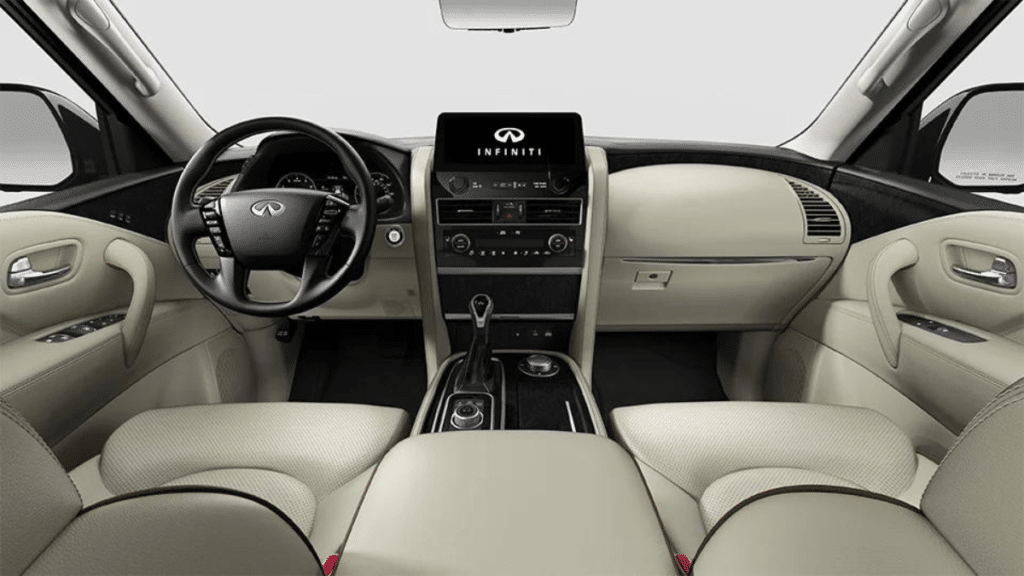

Fuel efficiency: Infiniti QX80
The QX80 consumes fuel at a rate consistent with what you’d expect from a full-size luxury SUV with a V8 engine. According to the EPA, the two-wheel drive model achieves a combined 16 mpg, with 14 mpg in the city and 20 mpg on the interstate. With the EPA putting its fuel efficiency at 15 mph combined, 13 mpg in the city, and 19 mpg on the interstate, I am somewhat expanding on four-wheel drive docks. This rating held during the week I drove a heavily equipped Sensory four-wheel-drive QX80 variant.
This average fuel efficiency is pretty good for the sector of full-size luxury SUVs, especially those with a V8 up front. The Escalade’s V6, in particular, has a combined EPA rating of 22 mpg, 20 mpg in the city, and 26 mpg on the highway. The LX and Navigator also have less thirsty V6 drivetrains. The QX80 performs somewhat better in EPA mileage testing than the V8-powered Escalade and Grand Wagoneer, most notably on open highways, for those who like a large, easy-driving V8 up front.
Safety and driver support technology:
The standard safety technology on the Infiniti QX80, even on the entry-level Luxe trim, contributes to its value. Every QX80 comes standard with lane departure prevention, backup collision intervention, front emergency braking with pedestrian recognition, and blind spot monitoring and intervention. A primary 360-degree camera and parking sensors make it simple to maneuver through narrow parking spaces, including on-screen directions that precisely forecast where the large SUV will go. Additionally, there is a typical camera-based rear-view mirror, but at night, headlights behind me would easily blind it. Fortunately, you can turn it off to use it as a regular mirror (although somewhat tinted).
Despite this, the QX80 falls short of its rivals in safety testing because of its outdated platform and apparatus. The SUV has not yet received a rating from the Insurance Institute for Highway Safety (IIHS), and the National Highway Traffic Safety Administration (NHTSA) has just recently upgraded the QX80’s rollover risk rating, giving it a three-star rating. The NHTSA further asserts that the QX80 does not comply with its current criteria for crash imminent braking and dynamic braking assistance, even tho-Infiniti incorporates a collision braking system as standard equipment. In 2020, it passed its last comprehensive NHTSA crash test, scoring four out of five stars for overall safety, five for side crash protection, and three for front crash prevention.
Comfort and Space
The QX80’s inside is tastefully finished and comfy, with Nappa leather, heated front seats, tri-zone automatic temperature control (for the driver, passenger, and rear), and a leather-wrapped heated steering wheel as standard. Moving up to the top Sensory trim upgrades the vehicle’s interior with quilted semi-aniline leather, a more sophisticated climate control system with automatic recirculation and additional environmental filtering, heated and ventilated front seats, heated outboard second-row seats, and one-touch folding of the second row.
Legroom is sufficient up front, with 39.6 inches in the front row and 41 inches in the second row. With just 28.8 inches of legroom, the third row may be uncomfortable for more prominent people, but a lady of average height will feel fine there. However, taller people may disagree. The second row’s button-operated chairs may be folded far enough for simple ingress and egress.
The Lexus LX is the full-size luxury SUV that comes closest to matching the smaller size of the QX80 in terms of inside space, with most of its competitors having substantially greater legroom. Even so, the new LX sacrifices some middle distance for a bit more capacity up front and back, with front legroom measuring 41.1 inches, center row legroom measuring 36.6 inches, and rear row legroom measuring 31.1 inches. It would be best to upgrade from the base-model LX, which costs $90,660, to acquire the third row. The third-row legroom in the Navigator, Jeep Grand Wagoneer, and Escalade is 36.1 inches, 36.6 inches, and 34.9 inches, respectively.

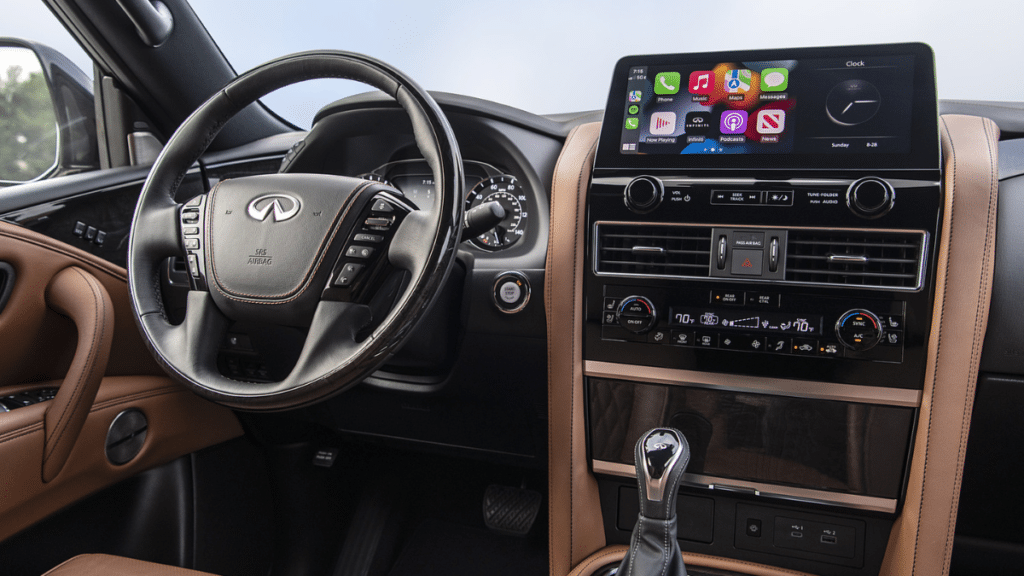
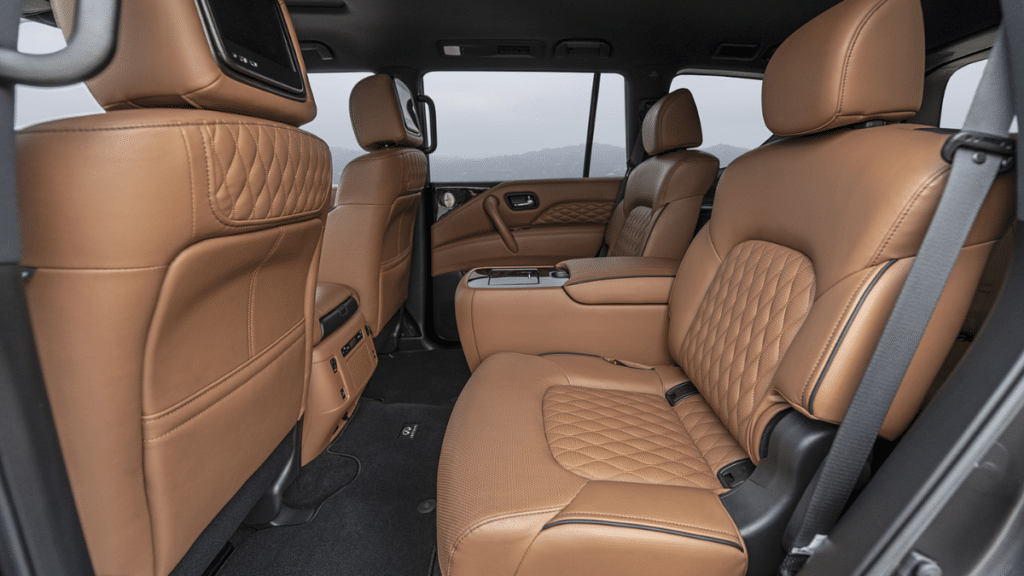

Infotainment: Infiniti QX80
Depending on your opinion on touchscreens, you may find the QX80’s interior to be horribly behind the times or among the finest, but one thing is sure: This place is retro. Thankfully, it has a straightforward layout and is simple to operate thanks to the 12.3-inch touchscreen in the middle and many tactile buttons. The only exception is the steering wheel’s audio, display, and cruise control buttons, arranged in two vertical columns. I found it simple to unintentionally push the incorrect steering wheel button as a driver with tiny hands.
Even though the QX80 isn’t state-of-the-art, it is well-appointed. Four USB ports, a new Amazon Alexa-powered speech assistant that often understood what I was saying, wireless Apple CarPlay, wired Android Auto, and others are all standard features. Thanks to a wireless smartphone charger discretely concealed beneath a panel in the center console, you can keep your phone out of sight and out of mind while driving. The cargo space and the rear of the central center console each include 12-volt power outlets, making it very simple to charge heavier appliances, tools, or camping gear.
Additionally, it has a 13-speaker Bose sound system with SiriusXM digital radio as standard equipment. The top Sensory trim upgrades this to a 17-speaker Bose system. A five-year subscription to TomTom Weather is also included with the QX80, allowing you to check weather predictions on the infotainment screen.
An HDMI connector and a backseat entertainment system with two 8-inch displays mounted on the backs of the front headrests are added by the top Sensory trim. This seemed a little outdated and clumsy after checking out the glitzy connected TV-style experience in the most recent Chrysler Pacifica. However, it should function well if you have anything lined up to view on an external device or memory stick.
Storage & Cargo Space:
The QX80 seems best suited for families that seldom need to fold up the third row unless you’re down to employ roof box, trailer, and footwell storage. The cargo space behind the third row is drastically reduced when it is up, going from 49.6 cubic feet to only 16.6 cubic feet. A tall roll of toilet paper may just fit, lay on its side, between the third row’s location and the back door’s rake.
The QX80 has an astounding 95.1 cubic feet of storage capacity when both back seats are folded. Overall, it offers more cargo space than the Lexus LX of comparable size, even behind the third row, which is surprising (with just 11 cubic feet). Still, it is much less than the much larger full-size luxury SUVs offered by Cadillac, Lincoln, and Jeep, where the smallest cargo space is 20 cubic feet on the Lincoln.
Being a sizeable body-on-frame SUV, the QX80 may make it difficult to load your belongings into the cargo space if you need to hoist anything heavy up from the ground. When I took the QX80 food shopping, the cargo area floor sat about as height as my shopping cart. Fortunately, even if you’re short, a typical motorized liftgate makes it simple to open and close.
Four cupholders and eight bottle holders on the center console guarantee that everyone has plenty of room to keep their beverages. The center console is intelligently built to give access to the deep bin from the second row. Customers who choose twin second-row captain’s chairs for their QX80 get a second center console.

Design: Infiniti QX80
Throughout the QX80’s lengthy existence, Infiniti has improved its appearance. Instead of the QX80’s ungainly, lumpy roofline, a sleeker, more streamlined design with just the right amount of chrome trimming has been adopted. Now a much more subtle luxury SUV, it’s ideal for those who think the existing Lexus LX’s “all grille” design is a little much. A single central screen replaces its outdated dual-screen infotainment system with excellent integration.
The inside carries this idea of “just enough glam,” with bits of chrome and burl wood that make controls and trim stand out in a cozy, soft leather sea. The vehicle has no uncomfortable seats, and the two power-folding rear rows make it simple to move people and stuff about as required. The design feels and seems sturdy.
Is the 2023 Infiniti QX80 Worth it?
The 2023 Infiniti QX80 is an excellent bargain for a full-size luxury SUV on an authoritarian body-on-frame basis with a starting price of $74,395. The QX80 is a good alternative if you don’t care about having the newest technologies or if you want internal controls that are more tactile. One of the bigger SUVs in the market, such as the Cadillac Escalade or Lincoln Navigator, may be preferable for larger families that use the third row for longer journeys. Still, the QX80 should offer enough capacity for school runs and off-road excursions for a family of four or five.
When you evaluate the sector, the top-of-the-line Sensory trim of the QX80 stands out as a fantastic deal. Starting prices for a QX80 Sensory with two-wheel drive are $86,045 (destination charge included), while prices with four-wheel purpose are $89,145. This four-wheel drive variant is less expensive than the base-model, two-row Lexus LX, which starts at $90,660. It also has three seats, an enhanced interior, a second-row multimedia system, and an additional hydraulic roll-stabilization system.
While the four-wheel drive is a luxury reserved for the top-of-the-line Escalade V, it isn’t even an option for under six figures. At $85,265 for the basic model with four-wheel drive, the Lincoln Navigator is less expensive than the QX80 Sensory. However, because it is a base model instead of a top trim, it has less equipment, such as no second-row infotainment system. Like the QX80 trim, the base-model Jeep Grand Wagoneer, which only comes in four-wheel drive, begins at $89,995.
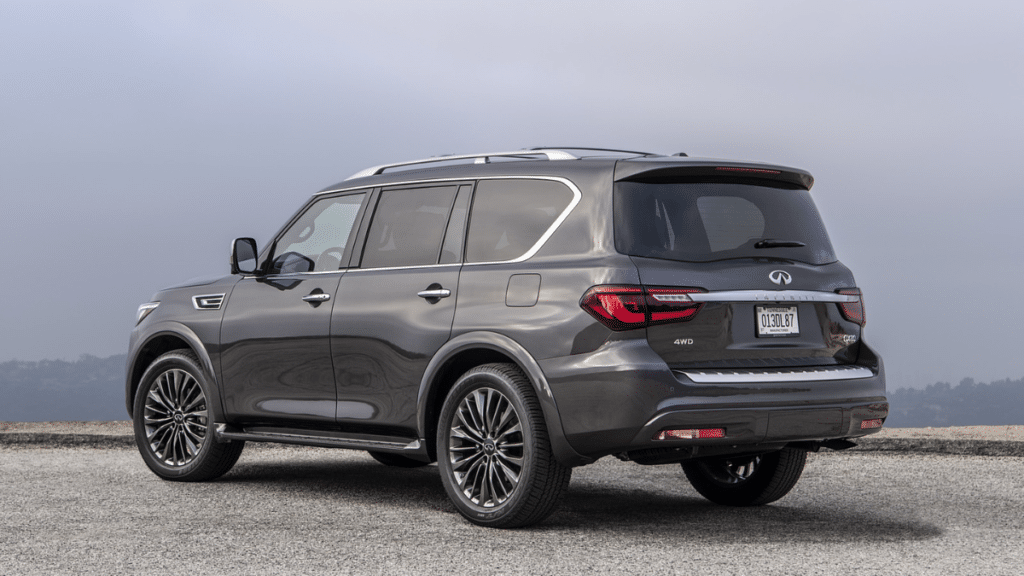
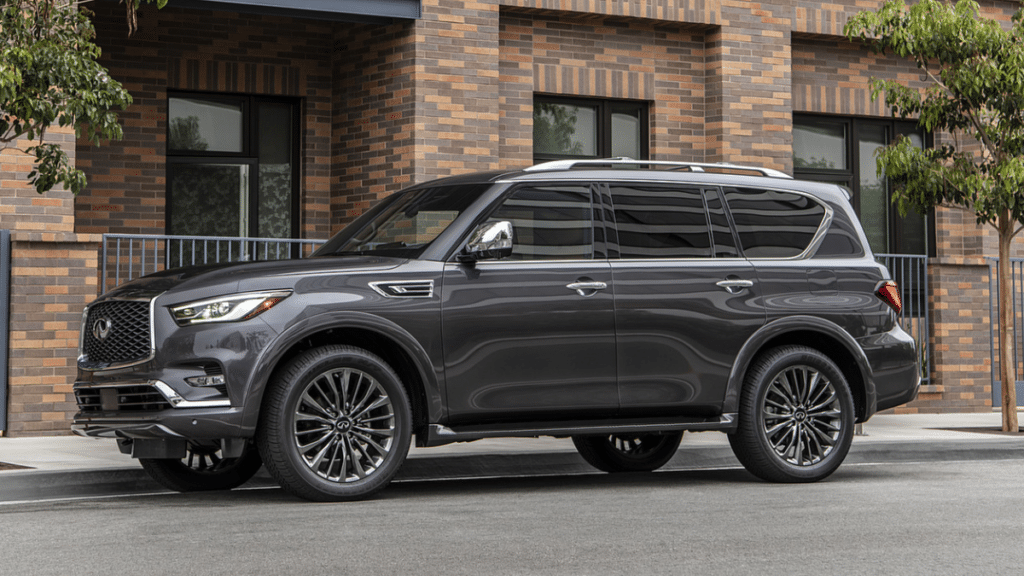
How Much Will Insurance for a 2023 Infiniti QX80 Cost?
The Infiniti QX80 has less expensive insurance rates than many of its rivals. Although this figure covers all 50 states, a typical 30-year-old female driver with a clean record should anticipate an average yearly premium of $2,760. Comparatively, the Lexus LX costs $3,226, the Cadillac Escalade starts at $3,004, and the Lincoln Navigator costs $2,854.
Verdict
Since its most recent significant makeover in 2011, the second-generation Infiniti QX80 has shown its age. Whatever the case, it has evolved into a fantastic bargain for a full-size, body-on-frame luxury SUV with eight passenger seats and a roomy, tastefully fitted cabin. Although its 400-horsepower V8 is as thirsty as that indicates, and its on-road characteristics aren’t as sophisticated as some of its rivals, its cheaper price point makes it an attractive package for anyone eager to leave the tarmac in luxury and elegance.




